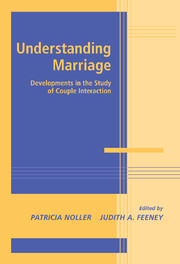Book contents
- Frontmatter
- Contents
- Contribitors
- Introduction
- SECTION ONE THE EFFECT OF COGNITION ON INTERACTION PATTERNS
- SECTION TWO UNDERSTANDING THE IMPORTANCE OF POSITIVE INTERACTION
- SECTION THREE COPING WITH DISAPPOINTMENT, CRITICISM, AND BETRAYAL
- Introduction to Section Three
- 8 Coping with Disappointment in Marriage: When Partners' Standards Are Unmet
- 9 On Empathic Accuracy and Husbands' Abusiveness: The “Overattribution Bias”
- 10 The War of the Roses: An Interdependence Analysis of Betrayal and Forgiveness
- SECTION FOUR POWER, CONFLICT, AND VIOLENCE IN MARITAL INTERACTION
- Marital interaction at important transition periods
- SECTION SIX Interventions for strengthening relationships
- Conclusions
- Index
- References
9 - On Empathic Accuracy and Husbands' Abusiveness: The “Overattribution Bias”
Published online by Cambridge University Press: 25 July 2009
- Frontmatter
- Contents
- Contribitors
- Introduction
- SECTION ONE THE EFFECT OF COGNITION ON INTERACTION PATTERNS
- SECTION TWO UNDERSTANDING THE IMPORTANCE OF POSITIVE INTERACTION
- SECTION THREE COPING WITH DISAPPOINTMENT, CRITICISM, AND BETRAYAL
- Introduction to Section Three
- 8 Coping with Disappointment in Marriage: When Partners' Standards Are Unmet
- 9 On Empathic Accuracy and Husbands' Abusiveness: The “Overattribution Bias”
- 10 The War of the Roses: An Interdependence Analysis of Betrayal and Forgiveness
- SECTION FOUR POWER, CONFLICT, AND VIOLENCE IN MARITAL INTERACTION
- Marital interaction at important transition periods
- SECTION SIX Interventions for strengthening relationships
- Conclusions
- Index
- References
Summary
The following scene is excerpted from Ernest Hemingway's book Men Without Women (Hemingway, 1927, pp. 81–82). Max and Al are professional hit men. They are dining in a restaurant while menacing the owner, George, and another diner, Nick.
Both men ate with their gloves on. George watched them eat.
“What are you looking at?” Max looked at George.
“Nothing.”
“The hell you were. You were looking at me.”
“Maybe the boy meant it for a joke, Max,” Al said. George laughed.
“You don't have to laugh,” Max said to him. “You don't have to laugh at all, see?”
“All right,” said George.
“So he thinks it's all right.” Max turned to Al. “He thinks it's all right. That's a good one.”
“Oh, he's a thinker,” Al said. They went on eating.
Toch (1969) used this example to illustrate that the likelihood of a potential aggressor becoming violent depends upon how that person interprets what other people say and do. In Hemingway's scenario, the killers evoke their own violent tendencies through a twisted interpretation of what George and Nick say or do. George's stare meant nothing – nothing at all. But both killers inferred that George was thinking or feeling contempt for them and that George's stare was direct evidence of that contempt. Once this inference had been made, anything George said or did from that point on only made the situation worse.
- Type
- Chapter
- Information
- Understanding MarriageDevelopments in the Study of Couple Interaction, pp. 228 - 250Publisher: Cambridge University PressPrint publication year: 2002
References
- 3
- Cited by



